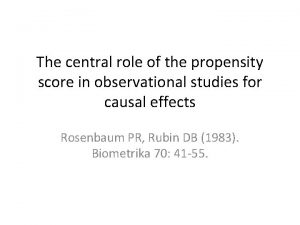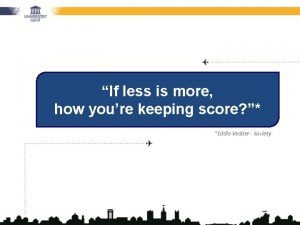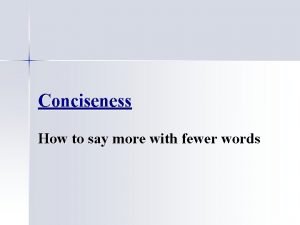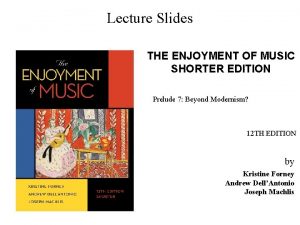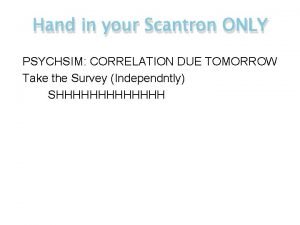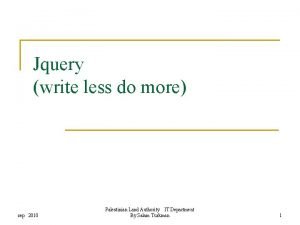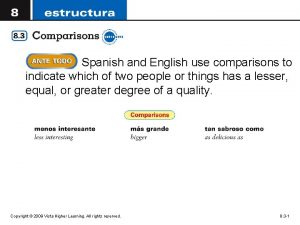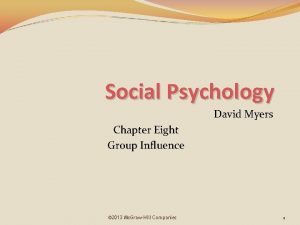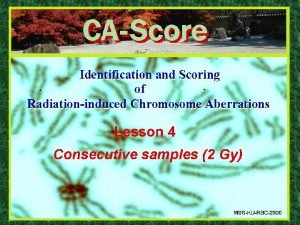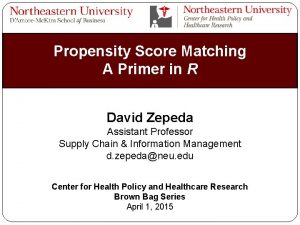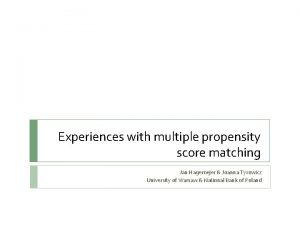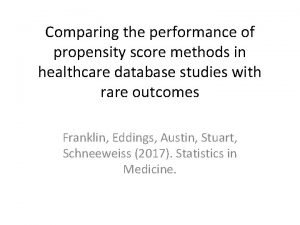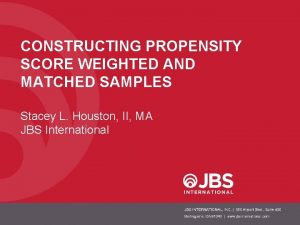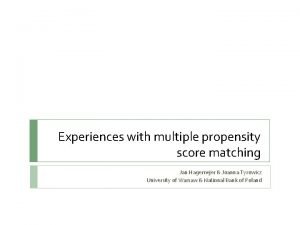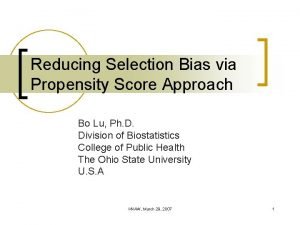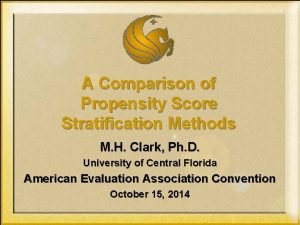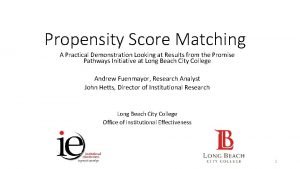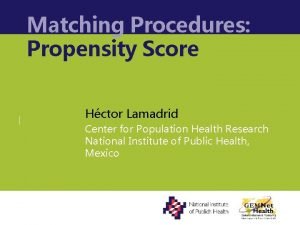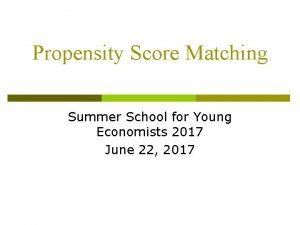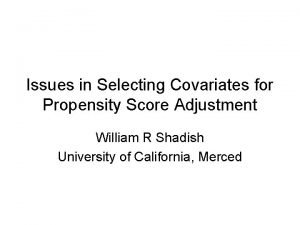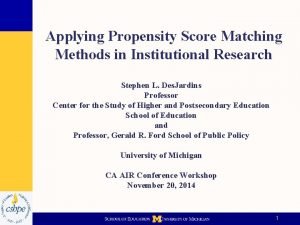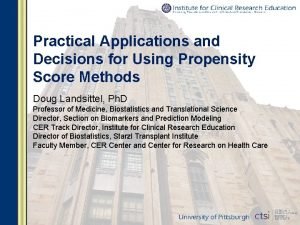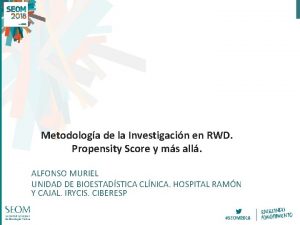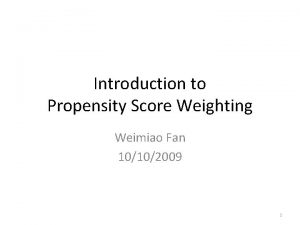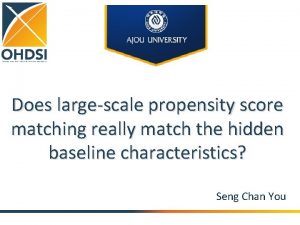Less Is More An Application of Propensity Score







































- Slides: 39

Less Is More? An Application of Propensity Score Stratification to First-Grade Retention Mieke Goos, Jan Van Damme, Patrick Onghena and Katja Petry SREE 2010

1. Introduction • Starting point: – Many young children struggle in elementary school – Countries deal with these early problems in a different way – Internationally frequently applied measure = grade retention

1. Introduction • Grade retention in Flanders: – Relatively high rate • For example: PISA 2003

1. Introduction – Relatively high rate … especially in Grade 1 § About 7% of Flemish children repeat Grade 1 – Socially approved by educators, policy makers and parents → being a grade retainee in Flanders has a different connotation than for example in the US (negative overtone) – No formal rules regarding grade promotion (no national/state standardized test procedures) → retention decision = joint decision by teacher and parents

1. Introduction • Research question: – Is Grade 1 retention an effective practice or not? • Focus of this study: – children’s psychosocial growth throughout elementary school

2. Method • Subjects: representative sample from the Flemish Si. BO-project – 3624 first-graders, of which 298 were retained – 222 classes – 121 schools followed until Grade 6

2. Method • Instruments – Psychosocial growth: Teacher questionnaire § rated yearly by the teacher § items on a 1 to 6 point Likert scale § 7 subscales Social skills • Popularity among classmates • Aggressive behavior • Hyperactive behavior • Asocial behavior Dynamic-affective attitudes and skills • Independent participation • School well-being • Self-confidence

2. Method • Instruments (continued) – Propensity of repeating Grade 1: § § § § official records achievement tests Standard Progressive Matrices teacher questionnaire about the child parent questionnaire teacher questionnaire about teacher didactics school staff questionnaire • 68 prior student characteristics • 59 prior class characteristics • 42 prior school characteristics

2. Method • Analyses: 4 -steps-procedure – Step 1: identification of ‘true’ confounders of Grade 1 retention § prior student, class and school characteristics § that are related to both treatment (i. e. , Grade 1 retention) and outcome (i. e. , children’s individual psychosocial growth) – Step 2: estimation of propensity scores based on these confounders § 3 -level logistic regression analysis (students – classes – schools)

2. Method • Analyses: 4 -steps-procedure (continued) – Step 3: decile stratification § 10 strata of equal size – Step 4: estimation of average psychosocial effects § 3 -level curvilinear growth curve analyses (measurements – students – schools)

2. Method • Analyses: 2 comparison strategies – Same-grade approach = comparing retainees with their younger grade-mates – Same-age approach = comparing retainees with their age-mates who were promoted to a higher grade

2. Method Research year 1 (age 7) Research year 2 (age 8) Research year 3 (age 9) 3 rd grade Cohort 1 E Cohort 2 on ti mo (not in Si. BO dataset) o Pr 2 nd grade C n tio o m 1 st grade A o Pr Grade retention on ti mo o B D Grade retention Pr F H on ti mo o Pr Grade retention G

2. Method Research year 1 (age 7) Research year 2 (age 8) Research year 3 (age 9) 3 rd grade Cohort 1 E Cohort 2 on ti mo (not in Si. BO dataset) o Pr 2 nd grade C n tio o m 1 st grade A o Pr Grade retention on ti mo o B D Grade retention Pr F SAME-GRADE COMPARISON H on ti mo o Pr Grade retention G

2. Method Research year 1 (age 7) Research year 2 (age 8) Research year 3 (age 9) 3 rd grade Cohort 1 E Cohort 2 on ti mo (not in Si. BO dataset) o Pr 2 nd grade C n tio o m 1 st grade A o Pr Grade retention on ti mo o B D Grade retention Pr F H on ti mo o Pr Grade retention G SAME-AGE COMPARISON

2. Method • Analyses: 2 comparison strategies (continued) – Why? ~ 2 different questions § How do Grade 1 repeaters, at the cost of one extra year of education, develop in comparison to younger children with whom they will eventually finish elementary school? SAME-GRADE APPROACH § How would Grade 1 retainees have developed, had they been promoted to Grade 2 instead? SAME-AGE APPROACH

3. Results • Propensity scores – based on 52 prior student characteristics Promoted students M = -4. 47 Retained students M = -0. 12

3. Results • Propensity score stratification – Cut-offs for strata based on overlap – Division into 10 strata of equal size

3. Results – Within-stratum balance in propensity score = ≠ ≠

3. Results – Within-stratum balance in 97% of the observed pre-retention student, class and school characteristics → Retained and promoted children within a certain stratum are equivalent (within sampling fluctuations) in terms of risk factors preceding retention

3. Results • Same-grade comparisons – On average: § during their retention year, Grade 1 retainees show a similar psychosocial functioning in comparison to younger grademates who are at similar risk of being retained § but … over time they (mostly) grow significantly slower they end up showing more hyperactive behavior, feeling less well at school etc. ! One exception: popularity among classmates

3. Results

3. Results sign

3. Results

3. Results sign

3. Results sign

3. Results sign

3. Results ! One exception ! sign

3. Results • Same-age comparisons – On average: § Grade 1 repeaters would have developed a similar or even better psychosocial functioning, had they been promoted to Grade 2 instead, both in the short and long run

3. Results sign

3. Results

3. Results sign

3. Results

3. Results sign

3. Results sign

3. Results sign

4. Conclusions and discussion • Overall, Grade 1 retainees do not seem to benefit much from their retention year – over time they grow slower compared to grademates, making them end up feeling less well at school etc. at the end of elementary school – while they would have developed a similar or even better psychosocial functioning, had they been promoted to Grade 2 instead → Practical implication: Our results call the practice of Grade 1 retention in Flanders into question

4. Conclusions and discussion • Future research is needed – Sensitivity analyses – Other outcome: growth in math and reading skills – Moderating effects: provision of additional support

----------------------------------------------------------2 ND BIENNIAL MEETING OF THE EARLI SPECIAL INTEREST GROUP 18 “Educational Effectiveness: Models, Methods and Applications” Leuven, Belgium 25 -27 August 2010 http: //www. sigee 2010. org ---------------------------------------------------------- Keynote lectures by Prof. Dr. Stephen Raudenbush, Prof. Dr. Robert E. Slavin, Prof. Dr. Jürgen Baumert and Prof. Dr. Jan-Eric Gustafsson

Thank you for your attention! Any suggestions or comments are welcome: mieke. goos@ped. kuleuven. be
 More more more i want more more more more we praise you
More more more i want more more more more we praise you More more more i want more more more more we praise you
More more more i want more more more more we praise you Propensity score theorem
Propensity score theorem Hundredths place rounding
Hundredths place rounding If less is more how you keeping score
If less is more how you keeping score Less religious and less idealized than greek art
Less religious and less idealized than greek art Propensity model meaning
Propensity model meaning Autonomous expenditure formula
Autonomous expenditure formula Tweet less kiss more
Tweet less kiss more Le corbusier less is more
Le corbusier less is more Less is more coco chanel
Less is more coco chanel Translation by a more neutral/less expressive word example
Translation by a more neutral/less expressive word example How to worry less and enjoy life more
How to worry less and enjoy life more How to say more with less words
How to say more with less words This period lasted from approximately 1775 - 1825
This period lasted from approximately 1775 - 1825 Had half impaired the nameless grace
Had half impaired the nameless grace Prelude 7. beyond modernism?
Prelude 7. beyond modernism? “the more you save, the less you spend” describes
“the more you save, the less you spend” describes Explore more worry less
Explore more worry less Write less do more
Write less do more He must become greater i must become less
He must become greater i must become less Half life more than 2 less than 4
Half life more than 2 less than 4 Axe less is more
Axe less is more Bone density z score
Bone density z score T-score statistics
T-score statistics 5 apples in a basket riddle
5 apples in a basket riddle The more you study the more you learn
The more you study the more you learn Aspire not to
Aspire not to Newton's first law
Newton's first law Knowing more remembering more
Knowing more remembering more More love to thee o lord
More love to thee o lord More choices more chances
More choices more chances Human history becomes more and more a race
Human history becomes more and more a race Future less vivid latin
Future less vivid latin Nonmetal, halogen family, atomic mass 35
Nonmetal, halogen family, atomic mass 35 Mips alu design
Mips alu design Tú eres (less) simpático que federico.
Tú eres (less) simpático que federico. Group polarization
Group polarization Screenless display seminar ppt download
Screenless display seminar ppt download Uranus was discovered accidentally in 1781
Uranus was discovered accidentally in 1781


